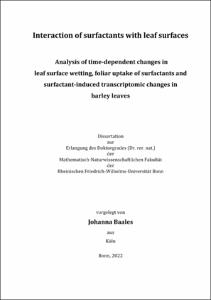Interaction of surfactants with leaf surfacesAnalysis of time-dependent changes in leaf surface wetting, foliar uptake of surfactants and surfactant-induced transcriptomic changes in barley leaves

Interaction of surfactants with leaf surfaces
Analysis of time-dependent changes in leaf surface wetting, foliar uptake of surfactants and surfactant-induced transcriptomic changes in barley leaves

| dc.contributor.advisor | Schreiber, Lukas | |
| dc.contributor.author | Baales, Johanna | |
| dc.date.accessioned | 2022-08-31T15:05:11Z | |
| dc.date.available | 2022-08-31T15:05:11Z | |
| dc.date.issued | 31.08.2022 | |
| dc.identifier.uri | https://hdl.handle.net/20.500.11811/10208 | |
| dc.description.abstract | Since a long time it is well known, that the cuticle covering above ground primary plant organs and provides a barrier against uncontrolled water loss between the plant and the atmosphere. In plant protection one of the major problems is that active ingredients have to pass through the hydrophobic cuticle to act inside plant cells. Drift-off, retention or wash-off can take place before those active ingredients reached the leaf interior. To prevent these factors, surfactants are always applied together with active ingredients to the plant surface to ensure their efficient use in the field. The wide use of active ingredients in plant protectionleads to a simultaneously high application of surfactants on plant surfaces in our environment, which might cause huge problems in plant physiology.The results of this dissertation showed that non-ionic, ionic and polar surfactants sprayed to leaf surfaces of Hordeum vulgare and Prunus laurocerasus at surface loads of 1 µg cm2 lead to 100 % wetting, while microstructures are not significantly or irreversible altered. Higher surfactant coverages lead to leaf damage as shown by photosynthesis measurements and an increase in transpiration. Furthermore, leaves were rapidly killed within a couple of hours and the wax structure was clearly altered as shown by chemical analysis. Time-dependent contact angle measurements indicated that surfactants are taken up into the leaves since contact angles were recovering. It could be shown that all used non-ionic surfactants are rapidly diffusing across the cuticle into the leaf tissue, whereas anionic, cationic and large polar surfactants did not. Moreover, there is a correlation between the velocity of the sorption into the leaf and the molecular weight and polarity of the applied non-ionic surfactant. Hence, by only measuring the contact angles over time, cuticular uptake of foliar applied surfactants can easily be measured and differences in the chemical and physical properties can be observed. Furthermore, it can also be postulated that subsequent surfactant applications will not necessarily change leaf surface properties and downstream metabolism, as long as there is enough time for surfactant diffusion into the leaf between subsequent applications. The analysis of transcriptomic changes by RNA sequencing provides a first inside into the complex metabolic mechanisms involved in the potential degradation and detoxification of non ionic surfactants within the living plant. A lot is known about plant responses and adaptations to xenobiotics as well as the degradation of non-ionic surfactants in soil and bacteria. This knowledge was used to identify and understand possible molecular and cellular mechanisms involved in the degradation and detoxification within the living plant. Major roles in those processes play Cytochromes P450, ABC transporters, acetyl- and methyl- transferases, as well as glutathione-S-transferases and glycosyltransferases. | en |
| dc.language.iso | eng | |
| dc.rights | In Copyright | |
| dc.rights.uri | http://rightsstatements.org/vocab/InC/1.0/ | |
| dc.subject | Kutikula | |
| dc.subject | Tenside | |
| dc.subject | Gerste | |
| dc.subject | Kontaktwinkel | |
| dc.subject | Aufnahme | |
| dc.subject | Abbau | |
| dc.subject | Surfactants | |
| dc.subject | Degradation | |
| dc.subject | Contact angle | |
| dc.subject | Barley | |
| dc.subject | Cuticle | |
| dc.subject.ddc | 580 Pflanzen (Botanik) | |
| dc.title | Interaction of surfactants with leaf surfaces | |
| dc.title.alternative | Analysis of time-dependent changes in leaf surface wetting, foliar uptake of surfactants and surfactant-induced transcriptomic changes in barley leaves | |
| dc.type | Dissertation oder Habilitation | |
| dc.publisher.name | Universitäts- und Landesbibliothek Bonn | |
| dc.publisher.location | Bonn | |
| dc.rights.accessRights | openAccess | |
| dc.identifier.urn | https://nbn-resolving.org/urn:nbn:de:hbz:5-67502 | |
| dc.relation.doi | https://doi.org/10.1007/s00425-021-03785-z | |
| ulbbn.pubtype | Erstveröffentlichung | |
| ulbbnediss.affiliation.name | Rheinische Friedrich-Wilhelms-Universität Bonn | |
| ulbbnediss.affiliation.location | Bonn | |
| ulbbnediss.thesis.level | Dissertation | |
| ulbbnediss.dissID | 6750 | |
| ulbbnediss.date.accepted | 22.06.2022 | |
| ulbbnediss.institute | Mathematisch-Naturwissenschaftliche Fakultät : Fachgruppe Biologie / Institut für Zelluläre und Molekulare Botanik (IZMB) | |
| ulbbnediss.fakultaet | Mathematisch-Naturwissenschaftliche Fakultät | |
| dc.contributor.coReferee | Weigend, Maximilian | |
| ulbbnediss.contributor.orcid | https://orcid.org/0000-0002-7568-8212 | |
| ulbbnediss.contributor.gnd | 1270226576 |
Files in this item
This item appears in the following Collection(s)
-
E-Dissertationen (4384)




